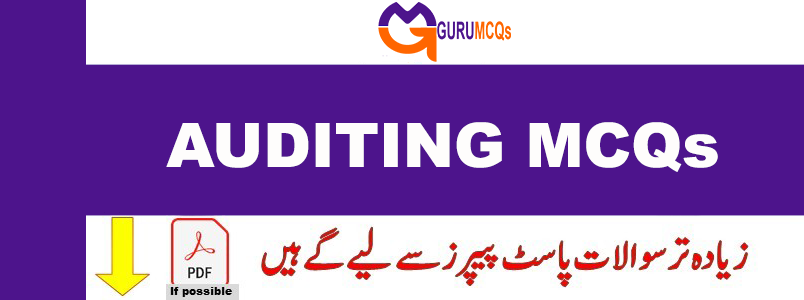
Utilizing MCQs is considered an effective method to assess a student’s understanding of a concept. The auditing MCQs are available on GuruMcQs.com and prepared by subject experts, aligning with current trends and practices. These MCQs are particularly beneficial for competitive examinations and tests such as PPSC, FPSC, SPSC, KPPSC, BPSC, and ETEA. They are also valuable for various job positions like Senior Auditor, Junior Auditor, Accountant, Internal Auditors, and External Auditors. Covering topics such as Basic Auditing, Financial Audit, Income Tax Audit, Internal Audit, Operational Auditing, and more, these MCQs offer comprehensive preparation. Additionally, you can find Cost Accounting MCQs with answers on the platform.
41. The auditor should examine subsequent realization of revenue such as dividends, interest,commission, etc to:_____________?
A. identify cases of unrecorded revenue
B. ensure proper disclosure in the balance sheet
C. recompute accrued income on the data of balance sheet
D. Any of these
42. What is meant by negative assurance?
A. The auditor cannot give an opinion due to lack of evidence.
B. The client’s financial statements were found to be materially misstated.
C. The auditor could not conduct any tests due to lack of controls.
D. The auditor did not find anything to indicate that a material misstatement exists.
43. For companies required to produce interim financial statements (IFI):
A. one audit firm should audit the IFI and a different firm should audit the financial statements for the year as a whole.
B. one accountancy firm should review the IFI and a different firm should audit the financial statements for the year as a whole.
C. the same firm should audit the IFI and the financial statements for the year as a whole.
D. the same firm should review the IFI and the financial statements for the year as a whole.
44. Which of the following statements is correct?
A. When a company negotiates a ‘friendly’ takeover, it usually appoints a firm of accountants to carry out due diligence on the takeover target.
B. In an attestation engagement, the accountant is required to report on the quality of work performed.
C. In a review engagement, evidence is gathered mainly by means of computation and inspection.
D. In an engagement to review financial statements, the amount of work required is the same as for an audit
45. What sort of assurance is provided in a review engagement?
A. Positive assurance
B. Negative assurance
C. High level of assurance
D. No assurance
46. Which one of the following is part of the auditor’s function?
A. Conducting the inventory count
B. Obtaining and evaluating audit evidence on the financial statements
C. Calculating the year-end accruals figure for inclusion in the accounts
D. Providing representations to management
47. Which of the following does NOT belong in the auditors’ report?
A. Introductory paragraph specifying the pages to which the report relates and the accounting convention adopted
B. Basis of the opinion
C. Involvement of any specialist
D. Statement of responsibilities of directors and auditors
48. What is meant by the expression ‘expectation gap’?
A. The gap between how the directors of a company perform their duties and how the shareholders expect them to perform
B. The gap between how the directors of a company perform their duties and how the general public expects them to perform
C. The gap between the public perception of the role of company auditors and their statutory role and responsibilities
D. The gap between the auditors’ own perception of their duties and how they are set out in the Companies Act
49. Which of the following would you not use as a benchmark for comparison when undertaking analytical procedures?
A. Other audit clients
B. Previous years
C. Other companies in the same industry
D. Budget
50. Which of the following is true about written representations?
A. They are the best source of audit evidence
B. They should be used only when there is a lack of other substantive audit evidence
C. They should be used only when there is other substantive audit evidence to complement it
D. Shareholders receive a copy of all material written representations
